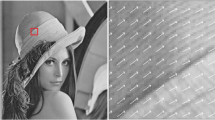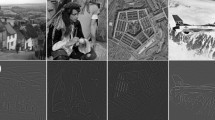Abstract
Dictionary learning is still a challenging problem in signal and image processing. In this paper, we propose an efficient block-structured incoherent dictionary learning algorithm for sparse representations of image signals. The constrained minimization of dictionary learning is achieved by iteratively alternating between sparse coding and dictionary update. Without relying on any prior knowledge of the group structure for the input data, we develop a two-stage clustering method that identifies the underlying block structure of the dictionary under certain restricted constraints. The two-stage clustering method mainly consists of affinity propagation and agglomerative hierarchical clustering. To meet the conditions of both the upper bound and the lower bound of the mutual coherence of dictionary atoms, we introduce a regularization term for the objective function to adjust the block coherence of the overcomplete dictionary. The experiments on synthetic data and real images demonstrate that the proposed dictionary learning algorithm has lower representation error, higher visual quality and better reconstructed results than most of the state-of-the-art methods.
中文摘要
字典学习是信号和图像处理领域中的一个挑战性问题。本文提出一种有效的块结构化非相干性的字典学习算法来提高图像信号的稀疏表示效果, 采用交替迭代最小化方法来求解字典学习优化的目标函数。通过稀疏编码和字典更新两个步骤的交替迭代来实现约束字典学习的优化设计。不依赖于输入图像信号的先验知识, 我们设计一种两阶段聚类分析方法来识别学习字典的潜在块结构。为了满足字典原子相干性的约束条件, 我们对字典学习优化的目标函数, 引入一种正则项用于调节超完备字典的块相干性。模拟数据和真实图像的实验结果表明, 与现有的绝大数最先进的方法相比, 本文所提的字典学习算法能够获得较小的表示误差、较高的视觉质量和较好的重建效果。
Similar content being viewed by others
References
Mairal J, Elad M, Sapiro G. Sparse representation for color image restoration. IEEE Trans Image Process, 2008, 17: 53–69
Zhang Z Y. Community structure detection in social networks based on dictionary learning. Sci China Inf Sci, 2013, 56: 078103
Olshausen B A, Field D J. Emergence of simple-cell receptive field properties by learning a sparse code for natural images. Nature, 1996, 381: 607–609
Vinje W E, Gallant J L. Sparse coding and decorrelation in primary visual cortex during natural vision. Science, 2000, 287: 1273–1276
Nirenberg S, Carcieri S M, Jacobs A L, et al. Retinal ganglion cells act largely as independent encoders. Nature, 2001, 411: 698–701
Fadili M J, Starck J L, Bobin J, et al. Image decomposition and separation using sparse representations: an overview. Proc IEEE, 2010, 98: 983–994
Elad M, Milanfar P, Rubinstein R. Analysis versus synthesis in signal priors. Inverse Probl, 2007, 23: 947–968
Bruckstein A M, Donoho D L, Elad M. From sparse solutions of systems of equations to sparse modeling of signals and images. SIAM Rev, 2009, 51: 34–81
Elad M. Sparse and redundant representation modeling-What next? IEEE Signal Process Lett, 2012, 19: 922–928
Mallat S, Zhang Z. Matching pursuits with time-frequency dictionaries. IEEE Trans Signal Process, 1993, 41: 3397–3415
Tropp J A. Greed is good: algorithmic results for sparse approximation. IEEE Trans Inf Theory, 2004, 50: 2231–2242
Cai T T, Wang L. Orthogonal matching pursuit for sparse signal recovery with noise. IEEE Trans Inf Theory, 2011, 57: 4680–4688
Rubinstein R, Zibulevsky M, Elad M. Efficient implementation of the K-SVD algorithm using batch orthogonal matching pursuit. Technical Report, CS, Technion, 2008
Eldar Y C, Kuppinger P, Bolcskei H. Block-sparse signals: uncertainty relations and efficient recovery. IEEE Trans Signal Process, 2010, 58: 3042–3054
Donoho D L, Tsaig Y, Drori I, et al. Sparse solution of underdetermined linear equations by stagewise orthogonal matching pursuit. IEEE Trans Inf Theory, 2012, 58: 1094–1121
Zhang W H, Zhou T, Huang B X. Outlier deletion based improvement on the StOMP algorithm for sparse solution of large-scale underdetermined problems. Sci China Inf Sci, 2014, 57: 092203
Needell D, Tropp J A. Cosamp: iterative signal recovery from incomplete and inaccurate samples. Appl Comput Harmonic Anal, 2009, 26: 301–321
Efron B, Hastie T, Johnstone I, et al. Least angle regression. Ann Statist, 2004, 32: 407–499
Dai W, Milenkovic O. Subspace pursuit for compressive sensing signal reconstruction. IEEE Trans Inf Theory, 2009, 55: 2230–2249
Blumensath T, Davies M E. Gradient pursuits. IEEE Trans Signal Process, 2008, 56: 2370–2382
Chen S S, Donoho D L, Saunders M A. Atomic decomposition by basis pursuit. SIAM Rev, 2001, 43: 129–159
Eldar Y C, Mishali M. Robust recovery of signals from a structured union of subspaces. IEEE Trans Inf Theory, 2009, 55: 5302–5316
Gorodnitsky I F, Rao B D. Sparse signal reconstruction from limited data using FOCUSS: a re-weighted minimum norm algorithm. IEEE Trans Signal Process, 1997, 45: 600–616
Wright M H. The interior-point revolution in optimization: history, recent developments, and lasting consequences. Bull Amer Math Soc, 2004, 42: 39–56
Elad M. Why simple shrinkage is still relevant for redundant representations. IEEE Trans Inf Theory, 2006, 52: 5559–5569
Bioucas-Dias J M, Figueiredo M A T. A new TwIST: two-step iterative shrinkage/thresholding algorithms for image restoration. IEEE Trans Image Process, 2007, 16: 2992–3004
Ahmed N, Natarajan T, Rao K R. Discrete cosine transform. IEEE Trans Comput, 1974, C-23: 90–93
Mallat S. A Wavelet Tour of Signal Processing, 3rd Edition: the Sparse Way. New York: Academic Press, 2008
Ma J, Plonka G. The curvelet transform. IEEE Signal Process Mag, 2010, 27: 118–133
Do M N, Vetterli M. The contourlet transform: an efficient directional multiresolution image representation. IEEE Trans Image Process, 2005, 14: 2091–2106
Do M N, Vetterli M. The finite ridgelet transform for image representation. IEEE Trans Image Process, 2003, 12: 16–28
Le Pennec E, Mallat S. Sparse geometric image representations with bandelets. IEEE Trans Image Process, 2005, 14: 423–438
Easley G, Labate D, Lim W Q. Sparse directional image representations using the discrete shearlet transform. Appl Comput Harmonic Anal, 2008, 25: 25–46
Tosic I, Frossard P. Dictionary Learning: what is the right representation for my signal? IEEE Signal Process Mag, 2011, 28: 27–38
Olshausen B A, Field D J. Sparse coding with an overcomplete basis set: a strategy employed by V1? Vis Res, 1997, 37: 3311–3325
Engan K, Aase S O, Hakon Husoy J. Method of optimal directions for frame design. In: Proceedings of IEEE International Conference on Acoustics, Speech, and Signal Processing, Phoenix, 1999. 2443–2446
Kreutz-Delgado K, Murray J, Rao B, et al. Dictionary learning algorithms for sparse representation. Neural Comput, 2003, 15: 349–396
Yaghoobi M, Blumensath T, Davies M E. Dictionary learning for sparse approximations with the majorization method. IEEE Trans Signal Process, 2009, 57: 2178–2191
Mairal J, Bach F, Ponce J, et al. Online learning for matrix factorization and sparse coding. J Mach Learn Res, 2010, 11: 19–60
Mairal J, Bach F, Ponce J. Task-driven dictionary learning. IEEE Trans Patt Anal Mach Intell, 2012, 34: 791–804
Schmid-Saugeon P, Zakhor A. Dictionary design for matching pursuit and application to motion-compensated video coding. IEEE Trans Circ Syst Video Technol, 2004, 14: 880–886
Aharon M, Elad M, Bruckstein A. K-SVD: an algorithm for designing overcomplete dictionaries for sparse representation. IEEE Trans Signal Process, 2006, 54: 4311–4322
Stewart G W. On the early history of the singular value decomposition. SIAM Rev, 1993, 35: 551–566
Zhang Y Q, Ding Y, Xiao J S, et al. Visibility enhancement using an image filtering approach. EURASIP J Appl Signal Process, 2012, 220: 1–6
Zhang Y Q, Ding Y, Liu J Y, et al. Guided image filtering using signal subspace projection. IET Image Process, 2013, 7: 270–279
Zelnik-Manor L, Rosenblum K, Eldar Y C. Dictionary optimization for block-sparse representations. IEEE Trans Signal Process, 2012, 60: 2386–2395
Eksioglu E M. A clustering based rramework for dictionary block structure identification. In: Proceedings of IEEE International Conference on Acoustics, Speech and Signal Processing, Prague, 2011. 4044–4047
Oiwa H, Matsushima S, Nakagawa H. Feature-aware regularization for sparse online learning. Sci China Inf Sci, 2014, 57: 052104
Barchiesi D, Plumbley M D. Learning incoherent dictionaries for sparse approximation using iterative projections and rotations. IEEE Trans Signal Process, 2013, 61: 2055–2065
Zhang Y Q, Liu J Y, Li M D, et al. Joint image denoising using adaptive principal component analysis and selfsimilarity. Inf Sci, 2014, 259: 128–141
Gribonval R, Nielsen M. Sparse representations in unions of bases. IEEE Trans Inf Theory, 2003, 49: 3320–3325
Engan K, Skretting K, Husoy J H. Family of iterative LS-based dictionary learning algorithms, ILS-DLA, for sparse signal representation. Digit Signal Process, 2007, 17: 32–49
Chi Y T, Ali M, Rajwade A, et al. Block and group regularized sparse modeling for dictionary learning. In: Proceedings of IEEE Conference on Computer Vision and Pattern Recognition, Portland, 2013. 1–8
Mairal J, Sapiro G, Elad M. Learning multiscale sparse representations for image and video restoration. Multiscale Model Simul, 2008, 7: 214–241
Ophir B, Lustig M, Elad M. Multi-scale dictionary learning using wavelets. IEEE J-STSP, 2011, 5: 1014–1024
Barthelemy Q, Larue A, Mayoue A, et al. Shift boolean and 2D rotation invariant sparse coding for multivariate signals. IEEE Trans Signal Process, 2012, 60: 1597–1611
Meng D Y, Zhao Q, Leung Y, et al. Learning dictionary from signals under global sparsity constraint. Neurocomputing, 2013, 119: 308–318
Peng Y, Meng D Y, Xu Z B, et al. Decomposable nonlocal tensor dictionary learning for multispectral image denoising. In: Proceedings of IEEE Conference on Computer Vision and Pattern Recognition, Columbus, 2014. 2949–2956
Bengio S, Pereira F, Singer Y, et al. Group sparse coding. In: Proceedings of Advances in Neural Information Processing Systems, Vancouver, 2009. 82–89
Gao S, Chia L T, Tsang I W. Multi-layer group sparse coding—for concurrent image classification and annotation. In: Proceedings of IEEE Conference on Computer Vision and Pattern Recognition, Providence, 2011. 2809–2816
Elhamifar E, Vidal R. Block-sparse recovery via convex optimization. IEEE Trans Signal Process, 2012, 60: 4094–4107
Strohmer T, Heath Jr R W. Grassmannian frames with applications to coding and communication. Appl Comput Harmonic Anal, 2003, 14: 257–275
Eldar Y C, Bolcskei H. Block-sparsity: coherence and efficient recovery. In: Proceedings of IEEE International Conference on Acoustics, Speech and Signal Processing, Taipei, 2009. 2885–2888
Murtagh F, Contreras P. Algorithms for hierarchical clustering: an overview. Data Min Knowl Discov, 2012, 2: 86–97
Frey B J, Dueck D. Clustering by passing messages between data points. Science, 2007, 315: 972–976
Wang C D, Lai J H, Suen C Y, et al. Multi-exemplar affinity propagation. IEEE Trans Patt Anal Mach Intell, 2013, 35: 2223–2237
Sigg C D, Dikk T, Buhmann J M. Learning dictionaries with bounded self-coherence. IEEE Signal Process Lett, 2012, 19: 861–864
Wang Z, Bovik A C, Sheikh H R, et al. Image quality assessment: from error visibility to structural similarity. IEEE Trans Image Process, 2004, 13: 600–612
Huynh-Thu Q, Ghanbari M. Scope of validity of PSNR in image/video quality assessment. Electron Lett, 2008, 44: 800–801
Duarte-Carvajalino J M, Sapiro G. Learning to sense sparse signals: simultaneous sensing matrix and sparsifying dictionary optimization. IEEE Trans Image Process, 2009, 18: 1395–1408
Author information
Authors and Affiliations
Corresponding authors
Rights and permissions
About this article
Cite this article
Zhang, Y., Xiao, J., Li, S. et al. Learning block-structured incoherent dictionaries for sparse representation. Sci. China Inf. Sci. 58, 1–15 (2015). https://doi.org/10.1007/s11432-014-5258-6
Received:
Accepted:
Published:
Issue Date:
DOI: https://doi.org/10.1007/s11432-014-5258-6




